Peican Zhu
SEER: Semantic Enhancement and Emotional Reasoning Network for Multimodal Fake News Detection
Jul 17, 2025Abstract:Previous studies on multimodal fake news detection mainly focus on the alignment and integration of cross-modal features, as well as the application of text-image consistency. However, they overlook the semantic enhancement effects of large multimodal models and pay little attention to the emotional features of news. In addition, people find that fake news is more inclined to contain negative emotions than real ones. Therefore, we propose a novel Semantic Enhancement and Emotional Reasoning (SEER) Network for multimodal fake news detection. We generate summarized captions for image semantic understanding and utilize the products of large multimodal models for semantic enhancement. Inspired by the perceived relationship between news authenticity and emotional tendencies, we propose an expert emotional reasoning module that simulates real-life scenarios to optimize emotional features and infer the authenticity of news. Extensive experiments on two real-world datasets demonstrate the superiority of our SEER over state-of-the-art baselines.
HyperDet: Source Detection in Hypergraphs via Interactive Relationship Construction and Feature-rich Attention Fusion
May 19, 2025Abstract:Hypergraphs offer superior modeling capabilities for social networks, particularly in capturing group phenomena that extend beyond pairwise interactions in rumor propagation. Existing approaches in rumor source detection predominantly focus on dyadic interactions, which inadequately address the complexity of more intricate relational structures. In this study, we present a novel approach for Source Detection in Hypergraphs (HyperDet) via Interactive Relationship Construction and Feature-rich Attention Fusion. Specifically, our methodology employs an Interactive Relationship Construction module to accurately model both the static topology and dynamic interactions among users, followed by the Feature-rich Attention Fusion module, which autonomously learns node features and discriminates between nodes using a self-attention mechanism, thereby effectively learning node representations under the framework of accurately modeled higher-order relationships. Extensive experimental validation confirms the efficacy of our HyperDet approach, showcasing its superiority relative to current state-of-the-art methods.
SourceDetMamba: A Graph-aware State Space Model for Source Detection in Sequential Hypergraphs
May 19, 2025Abstract:Source detection on graphs has demonstrated high efficacy in identifying rumor origins. Despite advances in machine learning-based methods, many fail to capture intrinsic dynamics of rumor propagation. In this work, we present SourceDetMamba: A Graph-aware State Space Model for Source Detection in Sequential Hypergraphs, which harnesses the recent success of the state space model Mamba, known for its superior global modeling capabilities and computational efficiency, to address this challenge. Specifically, we first employ hypergraphs to model high-order interactions within social networks. Subsequently, temporal network snapshots generated during the propagation process are sequentially fed in reverse order into Mamba to infer underlying propagation dynamics. Finally, to empower the sequential model to effectively capture propagation patterns while integrating structural information, we propose a novel graph-aware state update mechanism, wherein the state of each node is propagated and refined by both temporal dependencies and topological context. Extensive evaluations on eight datasets demonstrate that SourceDetMamba consistently outperforms state-of-the-art approaches.
EOOD: Entropy-based Out-of-distribution Detection
Apr 04, 2025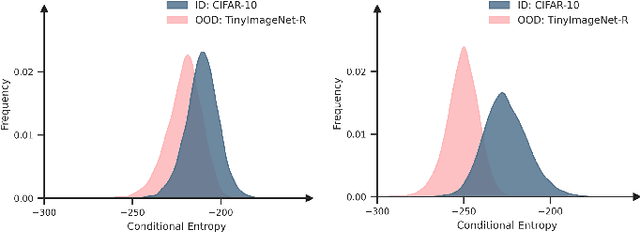

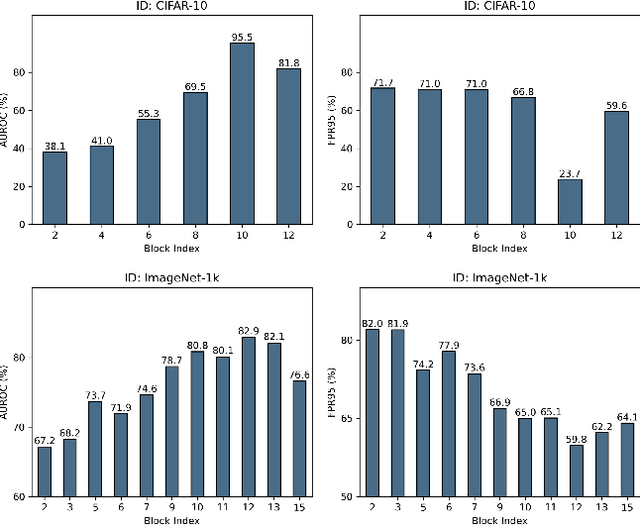
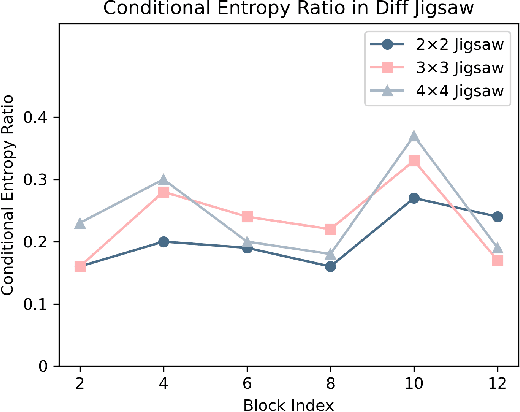
Abstract:Deep neural networks (DNNs) often exhibit overconfidence when encountering out-of-distribution (OOD) samples, posing significant challenges for deployment. Since DNNs are trained on in-distribution (ID) datasets, the information flow of ID samples through DNNs inevitably differs from that of OOD samples. In this paper, we propose an Entropy-based Out-Of-distribution Detection (EOOD) framework. EOOD first identifies specific block where the information flow differences between ID and OOD samples are more pronounced, using both ID and pseudo-OOD samples. It then calculates the conditional entropy on the selected block as the OOD confidence score. Comprehensive experiments conducted across various ID and OOD settings demonstrate the effectiveness of EOOD in OOD detection and its superiority over state-of-the-art methods.
Imperceptible Adversarial Attacks on Point Clouds Guided by Point-to-Surface Field
Dec 26, 2024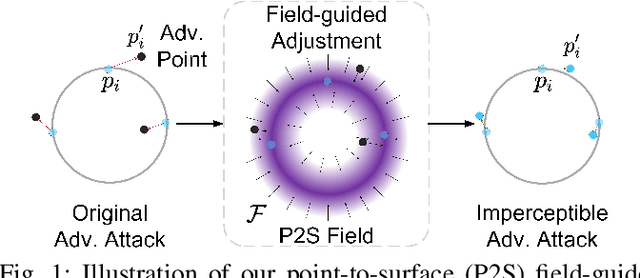
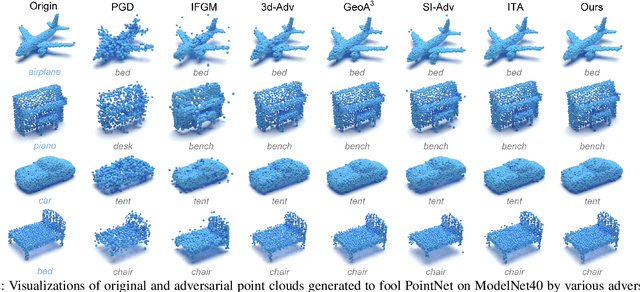

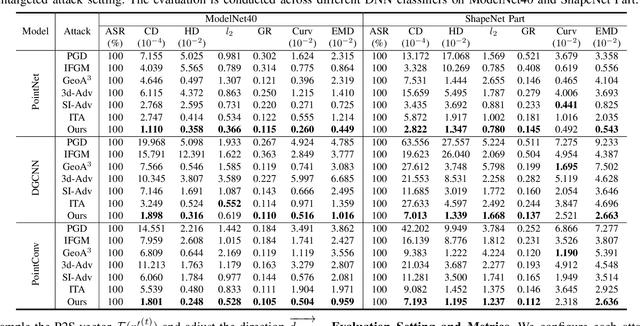
Abstract:Adversarial attacks on point clouds are crucial for assessing and improving the adversarial robustness of 3D deep learning models. Traditional solutions strictly limit point displacement during attacks, making it challenging to balance imperceptibility with adversarial effectiveness. In this paper, we attribute the inadequate imperceptibility of adversarial attacks on point clouds to deviations from the underlying surface. To address this, we introduce a novel point-to-surface (P2S) field that adjusts adversarial perturbation directions by dragging points back to their original underlying surface. Specifically, we use a denoising network to learn the gradient field of the logarithmic density function encoding the shape's surface, and apply a distance-aware adjustment to perturbation directions during attacks, thereby enhancing imperceptibility. Extensive experiments show that adversarial attacks guided by our P2S field are more imperceptible, outperforming state-of-the-art methods.
Hypergraph Attacks via Injecting Homogeneous Nodes into Elite Hyperedges
Dec 24, 2024Abstract:Recent studies have shown that Hypergraph Neural Networks (HGNNs) are vulnerable to adversarial attacks. Existing approaches focus on hypergraph modification attacks guided by gradients, overlooking node spanning in the hypergraph and the group identity of hyperedges, thereby resulting in limited attack performance and detectable attacks. In this manuscript, we present a novel framework, i.e., Hypergraph Attacks via Injecting Homogeneous Nodes into Elite Hyperedges (IE-Attack), to tackle these challenges. Initially, utilizing the node spanning in the hypergraph, we propose the elite hyperedges sampler to identify hyperedges to be injected. Subsequently, a node generator utilizing Kernel Density Estimation (KDE) is proposed to generate the homogeneous node with the group identity of hyperedges. Finally, by injecting the homogeneous node into elite hyperedges, IE-Attack improves the attack performance and enhances the imperceptibility of attacks. Extensive experiments are conducted on five authentic datasets to validate the effectiveness of IE-Attack and the corresponding superiority to state-of-the-art methods.
MHSA: A Multi-scale Hypergraph Network for Mild Cognitive Impairment Detection via Synchronous and Attentive Fusion
Dec 11, 2024Abstract:The precise detection of mild cognitive impairment (MCI) is of significant importance in preventing the deterioration of patients in a timely manner. Although hypergraphs have enhanced performance by learning and analyzing brain networks, they often only depend on vector distances between features at a single scale to infer interactions. In this paper, we deal with a more arduous challenge, hypergraph modelling with synchronization between brain regions, and design a novel framework, i.e., A Multi-scale Hypergraph Network for MCI Detection via Synchronous and Attentive Fusion (MHSA), to tackle this challenge. Specifically, our approach employs the Phase-Locking Value (PLV) to calculate the phase synchronization relationship in the spectrum domain of regions of interest (ROIs) and designs a multi-scale feature fusion mechanism to integrate dynamic connectivity features of functional magnetic resonance imaging (fMRI) from both the temporal and spectrum domains. To evaluate and optimize the direct contribution of each ROI to phase synchronization in the temporal domain, we structure the PLV coefficients dynamically adjust strategy, and the dynamic hypergraph is modelled based on a comprehensive temporal-spectrum fusion matrix. Experiments on the real-world dataset indicate the effectiveness of our strategy. The code is available at https://github.com/Jia-Weiming/MHSA.
A General Black-box Adversarial Attack on Graph-based Fake News Detectors
Apr 26, 2024Abstract:Graph Neural Network (GNN)-based fake news detectors apply various methods to construct graphs, aiming to learn distinctive news embeddings for classification. Since the construction details are unknown for attackers in a black-box scenario, it is unrealistic to conduct the classical adversarial attacks that require a specific adjacency matrix. In this paper, we propose the first general black-box adversarial attack framework, i.e., General Attack via Fake Social Interaction (GAFSI), against detectors based on different graph structures. Specifically, as sharing is an important social interaction for GNN-based fake news detectors to construct the graph, we simulate sharing behaviors to fool the detectors. Firstly, we propose a fraudster selection module to select engaged users leveraging local and global information. In addition, a post injection module guides the selected users to create shared relations by sending posts. The sharing records will be added to the social context, leading to a general attack against different detectors. Experimental results on empirical datasets demonstrate the effectiveness of GAFSI.
GIN-SD: Source Detection in Graphs with Incomplete Nodes via Positional Encoding and Attentive Fusion
Feb 27, 2024Abstract:Source detection in graphs has demonstrated robust efficacy in the domain of rumor source identification. Although recent solutions have enhanced performance by leveraging deep neural networks, they often require complete user data. In this paper, we address a more challenging task, rumor source detection with incomplete user data, and propose a novel framework, i.e., Source Detection in Graphs with Incomplete Nodes via Positional Encoding and Attentive Fusion (GIN-SD), to tackle this challenge. Specifically, our approach utilizes a positional embedding module to distinguish nodes that are incomplete and employs a self-attention mechanism to focus on nodes with greater information transmission capacity. To mitigate the prediction bias caused by the significant disparity between the numbers of source and non-source nodes, we also introduce a class-balancing mechanism. Extensive experiments validate the effectiveness of GIN-SD and its superiority to state-of-the-art methods.
Advancing Adversarial Robustness Through Adversarial Logit Update
Aug 29, 2023Abstract:Deep Neural Networks are susceptible to adversarial perturbations. Adversarial training and adversarial purification are among the most widely recognized defense strategies. Although these methods have different underlying logic, both rely on absolute logit values to generate label predictions. In this study, we theoretically analyze the logit difference around successful adversarial attacks from a theoretical point of view and propose a new principle, namely Adversarial Logit Update (ALU), to infer adversarial sample's labels. Based on ALU, we introduce a new classification paradigm that utilizes pre- and post-purification logit differences for model's adversarial robustness boost. Without requiring adversarial or additional data for model training, our clean data synthesis model can be easily applied to various pre-trained models for both adversarial sample detection and ALU-based data classification. Extensive experiments on both CIFAR-10, CIFAR-100, and tiny-ImageNet datasets show that even with simple components, the proposed solution achieves superior robustness performance compared to state-of-the-art methods against a wide range of adversarial attacks. Our python implementation is submitted in our Supplementary document and will be published upon the paper's acceptance.
 Add to Chrome
Add to Chrome Add to Firefox
Add to Firefox Add to Edge
Add to Edge